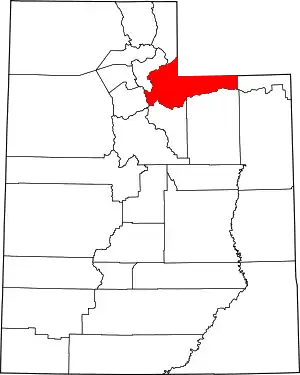Park City, Utah
Park City is a city in Summit County, Utah, United States. It is considered to be part of the Wasatch Back. The city is 32 miles (51 km) southeast of downtown Salt Lake City and 20 miles (32 km) from Salt Lake City's east edge of Sugar House along Interstate 80. The population was 7,558 at the 2010 census. On average, the tourist population greatly exceeds the number of permanent residents.
Park City, Utah | |
|---|---|
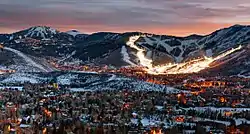 Overlooking Park City in November 2013 | |
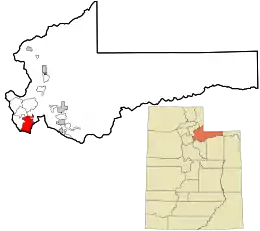 Location in Summit County and the state of Utah | |
| Coordinates: 40°39′34″N 111°29′59″W | |
| Country | United States |
| State | Utah |
| County | Summit |
| Founded | 1869[1] |
| Named for | Parley's Park |
| Government | |
| • Mayor | Andy Beerman |
| Area | |
| • Total | 19.99 sq mi (51.77 km2) |
| • Land | 19.99 sq mi (51.76 km2) |
| • Water | 0.00 sq mi (0.01 km2) |
| Elevation | 7,000 ft (2,100 m) |
| Population (2010) | |
| • Total | 7,558 |
| • Estimate (2019)[3] | 8,526 |
| • Density | 426.60/sq mi (164.71/km2) |
| Time zone | UTC−7 (Mountain) |
| • Summer (DST) | UTC−6 (Mountain) |
| ZIP Codes | 84060, 84068, 84098 |
| Area code | 435 |
| FIPS code | 49-58070[4] |
| GNIS feature ID | 1444206[5] |
| Website | www.parkcity.org |
After a population decline following the shutdown of the area's mining industry, the city rebounded during the 1980s and 1990s through an expansion of its tourism business. The city currently brings in a yearly average of $529.8 million to the Utah Economy as a tourist hot spot, $80 million of which is attributed to the Sundance Film Festival.[6] The city has two major ski resorts: Deer Valley Resort and Park City Mountain Resort. Both ski resorts were the major locations for ski and snowboarding events at the 2002 Winter Olympics. Although they receive less snow and have a shorter ski season than do their counterparts in Salt Lake County, such as Snowbird resort, they are much easier to access.
In 2015, Park City Ski Resort and Canyons resorts merged, creating the largest ski area in the U.S. In all, the resort boasts 17 slopes, 14 bowls, 300 trails and 22 miles of lifts.
The city is the main location of the United States' largest independent film festival, the Sundance Film Festival, home of the United States Ski Team, training center for members of the Australian Freestyle Ski Team, the largest collection of factory outlet stores in northern Utah, the 2002 Olympic bobsled/skeleton/luge track at the Utah Olympic Park, and golf courses. Some scenes from the 1994 film Dumb and Dumber were shot in the city. Outdoor-oriented businesses such as backcountry.com, Rossignol USA, and Skullcandy have their headquarters in Park City. The city has many retailers, clubs, bars, and restaurants, and has nearby reservoirs, hot springs, forests, and hiking and biking trails.
In the summertime, many valley residents of the Wasatch Front visit the town to escape high temperatures. Park City is usually cooler than Salt Lake City as it lies mostly higher than 7,000 feet (2,100 m) above sea level, while Salt Lake City is situated at an elevation of about 4,300 feet (1,300 m).
In 2008, Park City was named by Forbes Traveler Magazine as one of the "20 prettiest towns" in the United States.[7] In 2011, the town was awarded a Gold-level Ride Center designation from the International Mountain Bicycling Association for its mountain bike trails, amenities and community.[8]
History
The area was traveled by the early Mormon pioneers on their journey to where they settled and built Salt Lake City. One of their leaders, Parley P. Pratt, explored the canyon in 1848. He was given a charter the following year to build a toll road through it, which was finished in 1849.[9] The basin at the top of the canyon was an ideal place to graze, and a few families settled. Early on, the area was deeded to Samuel Snyder, Heber C. Kimball and Jedediah Grant. The settlers named it "Parley's Park City", which was shortened to "Park City" in the early 1900s. The first known discovery of ore in this area was by Colonel Patrick E. Connor, who instigated his men to search the area in bringing non-Mormons to the Utah region.[10] The finding of silver, gold and lead sparked the first silver mines in Park City in the 1860s. Park City's large mining boom brought large crowds of prospectors setting up camps around the mountain terrain, marking the first mining settlements. Although it was not the first find, the Ontario silver mine, discovered by Herman Buden in 1872 and later purchased by George Hearst, was the first major producer. In 1880, a spur line was established to the Echo station of the First Transcontinental Railroad.[11] By 1892 the Silver King Mine and its owners Thomas Kearns and David Keith took the spotlight as one of the most famous silver mines in the world.[10][12] While silver mines were doing well in Utah, other mines around the world were not doing as good, which drew many of these miners to Park City. The town flourished with crowds of miners and wealth, but by the 1950s, the town nearly became a ghost town. This was due in part to a drop in the price of silver.
The transformation of the town into a ski resort is primarily attributed to the silver need during and after World War I, as that and the Great Depression hurt the economy.[10][12] Once the site of the largest silver-mining camp in the country, the town was nearly destroyed by fire in 1898. Another accident occurred in 1902 when 34 miners were killed in an explosion in the Day West Mine. The mining community never fully recovered and so the town turned to skiing. The silver industry was suffering when 'Parkite' miners presented to Utahns Inc. a proposal for a ski resort called Treasure Mountain. This ski resort opened in 1963 on 10,000 acres (40 km2) of land the miners owned with mineral rights. This is said to be when tourists first largely began to visit Park City. This marks the beginning of the ski industry largely promoted by the Utah State Legislation as a destination resort.[12]
Since the rise of the skiing and tourist economy, Park City houses more tourists than residents. It has become a place of fame through the 2002 Winter Olympic Games and provides more attractions than ever before. In the 1950s, Utah began to use Park City as a mountain getaway, and not until D. James Canon promoted winter sports in Utah, with the promotional scheme of "Ski Utah" and "The Greatest Snow on Earth"[12] did many drive to see the city. Utah drew in over 648,000 tourists in 1970 and now a yearly average of 4 million tourists. In a town with a population of 8,000, the average number of tourists in Park City is 600,000 per year. This significant increase in visitors could be credited to promotional material that is distributed by the Utah Publicity and Tourist Council. Growth has accelerated in the last few decades, and Park City is now one of the most affluent resort towns in the United States.
According to the Bureau of Economic and Business Research, in 2012 travel, tourism and recreation generated $7.4 billion in spending and $960.6 million in state and local tax revenue for the State of Utah.[13] That same year Utah's total gross domestic product was $128 billion, making tourism 5.8% of GDP for the Utah economy as a whole.[14] Park City draws in 3,006,071 average annual visitors; in the winter 1,603,775, and in the summer 1,402,296. Park City benefits from the average nightly visitor spending $100 to $350. Currently, Park City primarily relies on its tourist industry from skiing to restaurants to hiking and biking. The makeover of Park City has stimulated a culture of expenditure, adventure, wealth, and this is included in their promotional material.
As recently as the 1920s, miners in Park City were using underground trains and shafts to gain access to the mountain for skiing. Aerial trams once used for hauling ore were converted into chairlifts. To this day, there are still more than 1,000 miles (1,600 km) of old silver-mine workings and tunnels beneath the slopes at Park City Mountain Resort and neighboring Deer Valley. On Main Street, 64 Victorian buildings are listed in the National Register of Historic Places. There are many remaining mine buildings, mine shafts (most blocked off from outsiders with large steel doors), and hoists, including the weathered remains of the California-Comstock and Silver King Mines and the water towers once used to hydrate one of the biggest mines, the Silver King, provide some history of this mining town transformed into a skiing resort.
.jpg.webp) Daly West and Quincy Mines in Park City (1911)
Daly West and Quincy Mines in Park City (1911)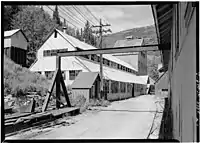 The Silver King Coalition mine was once the world's richest. Photo by Jack Boucher (1971).
The Silver King Coalition mine was once the world's richest. Photo by Jack Boucher (1971). Park City Utah Historical Wood Cabin
Park City Utah Historical Wood Cabin Historic Miners Hospital in Park City Utah
Historic Miners Hospital in Park City Utah.jpg.webp) Looking up Main Street, 2011
Looking up Main Street, 2011
Geography
According to the United States Census Bureau, the city has a total area of 17.567 square miles (45.50 km2), all land.
Park City is located at the south end of Snyderville Basin and climbs steep mountains to the southeast, south, and west. It is accessed by State Route 224 from Interstate 80 to the north and State Route 248 (Kearns Boulevard), which heads east to U.S. Route 40 and on to Kamas.
Climate
Summers in Park City are warm with cool nights, while winters are cold and snowy. The city has a humid continental climate (Köppen Dfb), though higher elevations within city limits may experience a subalpine (Dfc) or alpine (ET) climate.
| Climate data for Park City, Utah | |||||||||||||
|---|---|---|---|---|---|---|---|---|---|---|---|---|---|
| Month | Jan | Feb | Mar | Apr | May | Jun | Jul | Aug | Sep | Oct | Nov | Dec | Year |
| Record high °F (°C) | 64 (18) |
57 (14) |
71 (22) |
86 (30) |
91 (33) |
101 (38) |
100 (38) |
95 (35) |
91 (33) |
82 (28) |
71 (22) |
62 (17) |
101 (38) |
| Average high °F (°C) | 32.5 (0.3) |
36.1 (2.3) |
41.6 (5.3) |
53.0 (11.7) |
63.4 (17.4) |
74.3 (23.5) |
82.1 (27.8) |
79.6 (26.4) |
70.7 (21.5) |
58.4 (14.7) |
43.3 (6.3) |
34.4 (1.3) |
55.8 (13.2) |
| Average low °F (°C) | 11.8 (−11.2) |
15.0 (−9.4) |
19.9 (−6.7) |
27.9 (−2.3) |
36.3 (2.4) |
43.1 (6.2) |
50.0 (10.0) |
48.8 (9.3) |
40.5 (4.7) |
31.7 (−0.2) |
21.3 (−5.9) |
14.5 (−9.7) |
30.1 (−1.1) |
| Record low °F (°C) | −28 (−33) |
−28 (−33) |
−23 (−31) |
−4 (−20) |
12 (−11) |
11 (−12) |
21 (−6) |
20 (−7) |
8 (−13) |
6 (−14) |
−10 (−23) |
−30 (−34) |
−30 (−34) |
| Average precipitation inches (mm) | 2.71 (69) |
2.36 (60) |
2.24 (57) |
1.71 (43) |
1.46 (37) |
1.13 (29) |
1.26 (32) |
1.60 (41) |
1.16 (29) |
1.57 (40) |
1.69 (43) |
2.28 (58) |
21.17 (538) |
| Average snowfall inches (cm) | 25.8 (66) |
25.8 (66) |
24.7 (63) |
14.6 (37) |
3.9 (9.9) |
0.4 (1.0) |
0 (0) |
0 (0) |
1.4 (3.6) |
4.5 (11) |
17.9 (45) |
22.8 (58) |
141.8 (360.5) |
| Average precipitation days (≥ 0.01 in) | 9 | 9 | 9 | 8 | 6 | 5 | 4 | 5 | 5 | 6 | 7 | 8 | 81 |
| Source: | |||||||||||||
Demographics
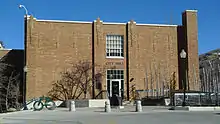
| Historical population | |||
|---|---|---|---|
| Census | Pop. | %± | |
| 1870 | 164 | — | |
| 1880 | 1,542 | 840.2% | |
| 1890 | 2,850 | 84.8% | |
| 1900 | 3,759 | 31.9% | |
| 1910 | 3,439 | −8.5% | |
| 1920 | 3,393 | −1.3% | |
| 1930 | 4,281 | 26.2% | |
| 1940 | 3,739 | −12.7% | |
| 1950 | 2,254 | −39.7% | |
| 1960 | 1,366 | −39.4% | |
| 1970 | 1,193 | −12.7% | |
| 1980 | 2,823 | 136.6% | |
| 1990 | 4,468 | 58.3% | |
| 2000 | 7,341 | 64.3% | |
| 2010 | 7,558 | 3.0% | |
| 2019 (est.) | 8,526 | [3] | 12.8% |
| source:[15][16] | |||
According to estimates from the U.S. Census Bureau,[17] as of 2016, there were 8,299 full-time residents in Park City. The racial makeup of the county was 78.8% non-Hispanic White, 1.1% Black, 0.1% Native American, 2.2% Asian, and 1.0% from two or more races. 16.8% of the population were Hispanic or Latino of any race.
2010 census
As of the census[18] of 2010, there were 7,558 people, 2,885 households, and 1,742 families residing in the city. The population density was 430.2 inhabitants per square mile (166.1/km2). There were 9,471 housing units at an average density of 539.1 per square mile (208.1/km2). The racial makeup of the city was 81.0% White, 0.6% African American, 0.30% Native American, 2.1% Asian, 0.3% Pacific Islander, 13.5% from other races, and 2.3% from two or more races. Hispanics or Latinos of any race were 24.1% of the population.
There were 2885 households, out of which 26.8% had children under the age of 18 living with them, 48.4% were married couples living together, 7.3% had a female householder with no husband present, 2.6% had a male householder with no wife present, and 39.6% were non-families. Of all households 25.8% were made up of individuals, and 5.0% had someone living alone who was 65 years of age or older. The average household size was 2.6 and the average family size was 3.03.
The age distribution was 23.0% under the age of 20, 7.2% from 20 to 24, 30.7% from 25 to 44, 30.4% from 45 to 64, and 8.5% who were 65 years of age or older. The median age was 37.4 years. For every 100 females, there were 112.3 males. For every 100 females age 18 and over, there were 114.7 males.
2000 census
As of the census[4] of 2000, the median income for a household in the city was $65,800, and the median income for a family was $77,137. Males had a median income of $40,032 versus $26,341 for females. The per capita income for the city was $45,164. About 5.3% of families and 10.0% of the population were below the poverty line, including 11.6% of those under age 18 and 6.6% of those age 65 or over.
Education
Park City High School is located at 1752 Kearns Blvd, Park City, Utah. Park City School District's size is in the middle of the other Utah school districts, with more than 4,500 students. It is also close to the state average ethnic minority composition. Of its students 17% are ethnic minorities—mostly of Hispanic heritage. The school provides its students with a series of film and TV production classes, and hosts "The Miner Film Festival" each year for students to enter their films and show them at the Eccles Center.
Infrastructure
Transit
Park City operates its own free intra-city transit system (with additional service to limited areas of Summit County northeast of town). Routes include service to the Canyons Village, Deer Valley Resort, Empire Pass, Jeremy Ranch Park & Ride lot, Kimball Junction, Park City Resort, Park Meadows, Pinebrook, Prospector Square, Silver Lake Village, Silver Springs, Silver Summit/Highland Estates, and Thaynes Canyon.[19] Bus service is offered between Park City and Salt Lake City via the PC-SLC Connect, run by the Utah Transit Authority.[20]
Sister cities
 Courchevel (Savoy), France
Courchevel (Savoy), France
Notable people
- Ken Block: DC Shoes founder, Rally Car driver
- Rosie Brennan: 2018 Olympic cross country skier[21]
- Ashley Caldwell: 2010, 2014, and 2018 Olympic freestyle skier[21]
- Brett Camerota: 2010 Olympic silver medalist in team Nordic combined
- Joss Christensen: first Olympic gold medalist in ski Slopestyle in 2014
- Virginia Cutler: educator
- Gregg Deal: Artist
- Bill Demong: 2010 Olympic gold and silver medalist in individual and team Nordic combined
- Dusty Dvorak: 1984 Olympic gold medalist volleyball; inducted into Volleyball Hall of Fame in 1998
- Mark Eaton: professional basketball player for Utah Jazz
- Bill Engvall: Blue Collar Comedy Tour comedian
- Stein Eriksen: 1952 Olympic gold and silver medalist in Alpine skiing; freestyle skiing innovator and skiing legend
- Bud Feltman: 1964 Olympian in luge; former Vice President of Scott USA and Smith USA
- Brandon Flowers: Award winning lead singer of The Killers and solo artist
- Edward J. Fraughton: sculptor, Inventor
- John W. Gallivan: publisher of The Salt Lake Tribune from 1960 to 1984
- Alex Hall: Winter X Games gold medalist and a participant in the 2018 Winter Olympics as a freestyle skier[22][21]
- Tanner Hall: Freeskier and multiple Winter X Games medalist as a freestyle skier
- Phil L. Hansen: former Utah attorney general
- William Jefferson Hardin: black legislator
- George Hearst: mining entrepreneur, U.S. Senator, and founder of what became the Hearst Corporation news dynasty
- Eric Heiden: winner of all five individual speed skating gold medals at 1980 Olympics, Park City resident;[23] maintains orthopedic surgery office in city[24]
- Sarah Hendrickson: 2014 and 2018 Olympic ski jumper; was the first woman in an Olympic Games as the event was added in 2014[21]
- Steven Holcomb: U.S. Bobsled Team at the 2010 Winter Olympics and gold medalist in the 4-man bobsled event.
- Whitney Jensen: ballet dancer
- Jessica Jerome: 2014 Olympic ski jumper; was the first woman to qualify for an Olympic Games in the event.
- Thomas Kearns: U.S. Senator 1883–1918, owner of Silver King Coalition Mining Co.
- Sage Kotsenburg: first Olympic gold medalist in Snowboard Slopestyle in 2014
- Ted Ligety: 2006 and 2014 Olympic gold medalist in Alpine skiing[21]
- Mike Massey: professional pocket billiards (pool) player
- Danny Masterson: actor, best known as Hyde from That '70s Show
- Roger I. McDonough: Utah Supreme Court Chief Justice
- Megan McJames: 2010, 2014, and 2018 Olympic slalom skier[21]
- Jim Nantz: sportscaster
- Madison Olsen: 2018 Olympic freestyle skier[21]
- Hal Prewitt: racecar driver and businessman
- Elli Reed: professional soccer player
- Harry Reems: 1970s porn star
- William Rhoads: 2018 Olympic ski jumper[21]
- Abby Ringquist: 2018 Olympic ski jumper[21]
- Mitt Romney: former Governor of Massachusetts, 2012 GOP Presidential nominee, Senator from Utah
- Summer Sanders: 1992 Olympic gold medalist in swimming; sports commentator, television personality and actress
- John Schnatter: businessman and founder of Papa John's Pizza
- Jimmy Shea: 2002 Olympic gold medalist in skeleton; only third-generation U.S. Olympian
- Barry Sims: NFL offensive lineman for San Francisco 49ers, graduated from Park City High School
- Will Smith: star of The Fresh Prince of Bel-Air and Men in Black films.[25]
- Kevin Sorbo: star of Hercules: The Legendary Journeys, God's Not Dead and Let There Be Light. He and his wife Sam own a house in Park City's Saint Regis Deer Valley resort.[25]
- John Terry: actor known for playing Christian Shephard on Lost
- Roger J. Traynor: Chief Justice of the California Supreme Court
- Ronnie Vannucci Jr.: drummer from the American rock band The Killers
- McRae Williams: Freestyle skier at the 2018 Winter Olympics[26]
- Montel Williams: television actor and former tabloid talk show host. He owns a house within Park City's urban community.[27]
- Treat Williams: actor known for films and playing Dr. Andrew Brown in Everwood
- Bradley Wilson: Mogul skier at the 2014 and 2018 Winter Olympics[28][21]
- Bryon Wilson: 2010 Olympic bronze medalist in Mogul skiing[29][21]
- Scott Wolf: television and film actor known for playing Bailey Salinger on Party of Five
See also
- List of cities and towns in Utah
- National Register of Historic Places listings in Summit County, Utah
- Ontario silver mine
Notes
- http://www.parkcity.org/index.aspx?page=280
- "2019 U.S. Gazetteer Files". United States Census Bureau. Retrieved 7 August 2020.
- "Population and Housing Unit Estimates". United States Census Bureau. 24 May 2020. Retrieved 27 May 2020.
- "U.S. Census website". United States Census Bureau. Retrieved 31 January 2008.
- "US Board on Geographic Names". United States Geological Survey. 25 October 2007. Retrieved 31 January 2008.
- http://www.sundance.org/pdf/festival-info/sff15-economic-impact-report.pdf>
- Giuffo, John (12 April 2011). "America's Prettiest Towns". Forbes. Archived from the original on 15 August 2011. Retrieved 5 March 2014.
- "Park City (UT) Gold-level – International Mountain Bicycling Association". Retrieved 5 March 2014.
- Strack, Don (12 September 2004), "The Golden Pass: A History of Transportation in Parleys Canyon, Utah", UtahRails.net
- Balls, Jami, "Places: Olympic Locations", HistoryToGo.Utah.gov, Utah Division of State History, Utah Department of Heritage & Arts, State of Utah
- "Park City History Timeline". parkcityhistory.org. Park City Museum. Retrieved 22 December 2020.
- Rugh, Susan Sessions (2006). "Branding Utah: Industrial Tourism in the Postwar American West". The Western Historical Quarterly. Archived from the original on 11 March 2007.
- McCord, Keith. "Utah tourism industry poised to hit $1B in tax revenue". DeseretNews.com. Retrieved 20 March 2016.
- "Total Gross Domestic Product for Utah". research.stlouisfed.org. Retrieved 20 March 2016.
- Moffatt, Riley. Population History of Western U.S. Cities & Towns, 1850–1990. Lanham: Scarecrow, 1996, 309.
- "Subcounty population estimates: Utah 2000–2007" (CSV). United States Census Bureau, Population Division. 18 March 2009. Retrieved 10 May 2009.
- "U.S. Census Bureau QuickFacts". U.S. Census Bureau. Retrieved 29 April 2018.
- "U.S. Census website". United States Census Bureau. Retrieved 14 May 2011.
- http://www.parkcity.org/Modules/ShowDocument.aspx?documentid=3729
- "parkcity.org".
- "Meet the Utah athletes who will compete in the Pyeongchang Olympic Games". The Salt Lake Tribune. 4 February 2018.
- "Park City's Alex Hall takes slopestyle gold in X Games". The Park Record. 28 January 2019.
- "Eric Heiden, M.D." Heiden Orthopedics. Retrieved 10 February 2017.
- Caple, Jim (10 February 2017). "How Dr. Eric Heiden earned place among America's greatest athletes". ESPN. Retrieved 10 February 2017.
- https://www.ksl.com/article/45799086/10-celebrities-with-homes-in-utah
- "For McRae Williams, the goal was never World Championships". The Park Record. 1 February 2019.
- https://www.ksl.com/article/36973453/13-celebrities-with-homes-in-utah
- "Bradley Wilson U.S. Ski Team – Freestyle". US Ski Team. Retrieved 1 February 2019.
- "Bryon Wilson". IDOne USA. Retrieved 27 July 2016.
References
- "Economic Profile: Tourism: Park City and Summit County Utah". Park City Chambers of Commerce, Convention & Visitors Bureau, 2009.
- Struck, Don (14 September 2013), "From Echo to Park City: The Story of Union Pacific's Park City Branch", UtahRails.net. An earlier version of this article appeared in "From Echo to Park City", The Streamliner, vol. 15 no. 2, Spring 2001
External links
![]() Media related to Park City, Utah at Wikimedia Commons
Media related to Park City, Utah at Wikimedia Commons
![]() Park City travel guide from Wikivoyage
Park City travel guide from Wikivoyage
- "GOVERNMENTAL UNIT REFERENCE MAP (2019): Summit County, UT" (PDF). U.S. DEPARTMENT OF COMMERCE U.S. Census Bureau. p. 32.
